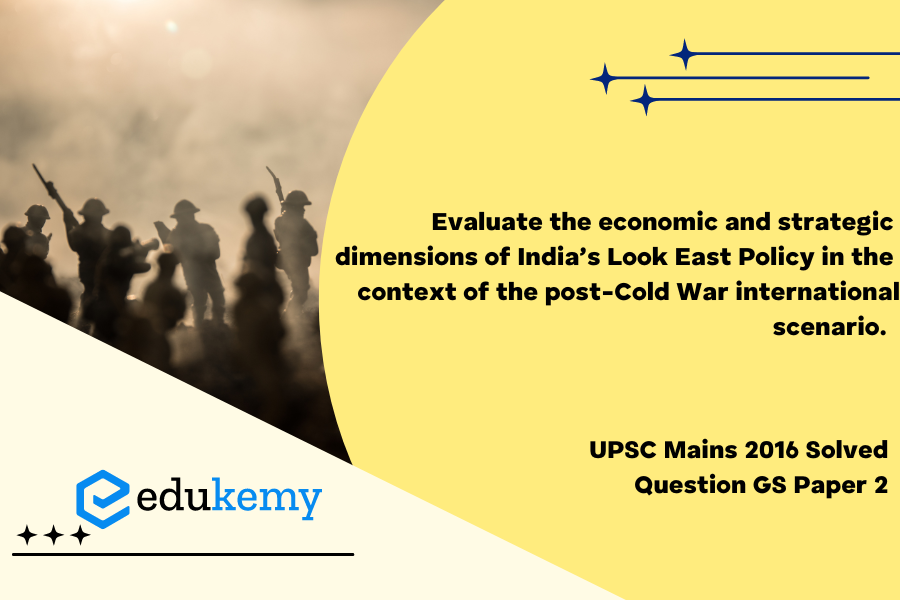India’s Look East Policy, conceived in the wake of the post-Cold War international scenario, represents a pivotal aspect of the country’s diplomatic and economic engagement strategy. As the geopolitical landscape underwent significant transformations, India sought to reorient its foreign policy towards the dynamic Asia-Pacific region. The economic and strategic dimensions of this policy are multifaceted, encapsulating India’s aspirations for regional stability, economic growth, and global relevance. On the economic front, the Look East Policy aimed to capitalize on the burgeoning economies of East and Southeast Asia, fostering trade partnerships and enhancing India’s economic clout in the global arena. Simultaneously, strategically, the policy aimed at countering the challenges posed by China’s rising influence in the region, while strengthening ties with traditional allies and fostering new partnerships. The policy’s evolution reflects India’s recognition of the interconnectedness of economic prosperity and strategic influence, underscoring the importance of navigating a delicate balance in a rapidly changing world order. This analysis delves into the nuanced interplay between India’s economic interests and strategic imperatives within the context of the post-Cold War international scenario, shedding light on the policy’s impact on India’s geopolitical standing and economic trajectory.
Tag: Bilateral, regional and global groupings and agreements involving India and/or affecting India’s interests.
Contents
Decoding the Question:
- In the Introduction, try to start your answer with a brief introduction on Look East Policy.
- In Body,
- Discuss both the economic and strategic dimensions of India’s Look East Policy.
- In Conclusion, try to write the overall significance of Policy.
Answer:
The Look East Policy of India, framed by the Narasimha Rao government in 1992 for better engagement with East Asian and Southeast Asian nations. It aims to promote economic, strategic, and cultural relations with the vast Asia-Pacific region at different levels. In the Post-Cold War period, there was a strong rationale for India to cultivate closer relations with the countries of the region for mutual benefit.

Economic Dimensions of India’s Look East Policy:
- Trade and Economic Integration: India’s Look East Policy, initiated in the early 1990s and later evolved into the Act East Policy, focused on deepening economic ties with Southeast Asian nations and East Asian economies. The policy aimed to tap into the economic dynamism of the region, promoting trade liberalization, and fostering economic integration. Enhanced economic engagement has resulted in increased trade volumes, business collaborations, and foreign direct investments.
- Connectivity and Infrastructure Development: The policy underscores the importance of robust infrastructure and connectivity projects to facilitate smoother trade flows. Initiatives like the India-Myanmar-Thailand Trilateral Highway and the Kaladan Multimodal Transit Transport Project have been pivotal in strengthening physical connectivity, reducing trade barriers, and boosting economic activities across borders.
- Regional Economic Blocs and Partnerships: India’s Look East Policy has led to active participation in regional economic groupings such as the Association of Southeast Asian Nations (ASEAN) and the East Asia Summit (EAS). These platforms provide India with opportunities to integrate into regional supply chains, engage in economic dialogues, and pursue collaborative projects that contribute to shared economic development.
Strategic Dimensions of India’s Look East Policy:
- Geostrategic Balance in the Asia-Pacific: In the post-Cold War era, the Look East Policy serves as a strategic tool for India to balance geopolitical influences in the Asia-Pacific region. The policy helps in mitigating the dominance of any single power and fosters a multipolar order, aligning with India’s vision of a stable and inclusive regional security architecture.
- Maritime Security and Freedom of Navigation: With an increasing emphasis on maritime security, the Look East Policy addresses concerns related to piracy, terrorism, and ensuring the freedom of navigation in critical sea lanes. India’s engagement with Southeast Asian nations enhances collective efforts to maintain regional stability, protect maritime interests, and respond to security challenges in the Indian Ocean and the South China Sea.
- Counterbalancing China’s Influence: Given the rising influence of China in the region, India’s Look East Policy serves as a strategic counterbalance. By strengthening partnerships with countries in Southeast Asia and East Asia, India aims to diversify its strategic options, ensuring that the region remains multipolar, free from undue hegemony, and supportive of India’s security interests.
- Diplomatic and Defense Cooperation: The Look East Policy fosters robust diplomatic and defense ties with nations in the region. Bilateral and multilateral defense engagements, joint military exercises, and defense technology cooperation contribute to building strategic partnerships. These collaborations enhance India’s capabilities and reaffirm its commitment to regional security.
India’s Look East Policy was predominantly economic, but later it acquired strategic dimensions too. In 2014 the government upgraded the Look East Policy, by intensive and continuous engagement with Southeast Asian countries in the field of connectivity, trade, culture, defense, and people-to-people-contact at bilateral, regional, and multilateral levels. India forged partnerships with several countries in the region; its impressive economic growth has created a sound basis for its relations with the Asia-Pacific.
In case you still have your doubts, contact us on 9811333901.
For UPSC Prelims Resources, Click here
For Daily Updates and Study Material:
Join our Telegram Channel – Edukemy for IAS
- 1. Learn through Videos – here
- 2. Be Exam Ready by Practicing Daily MCQs – here
- 3. Daily Newsletter – Get all your Current Affairs Covered – here
- 4. Mains Answer Writing Practice – here


